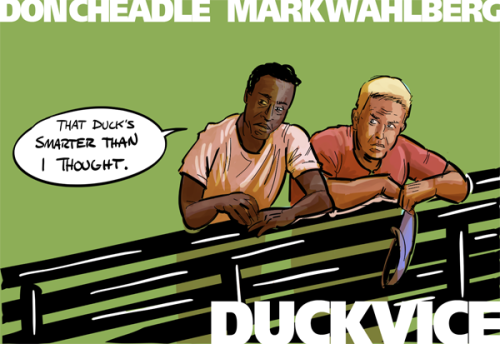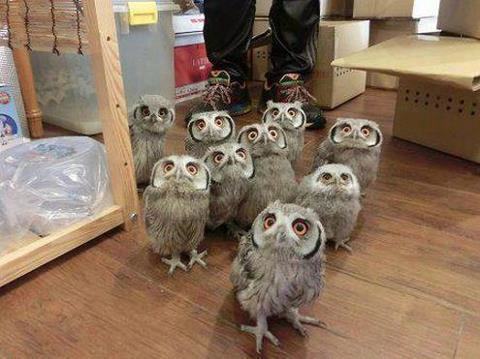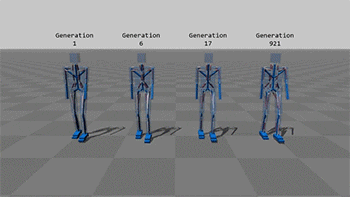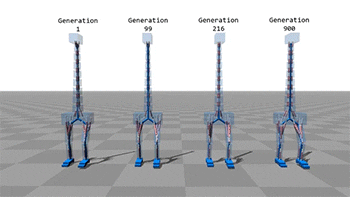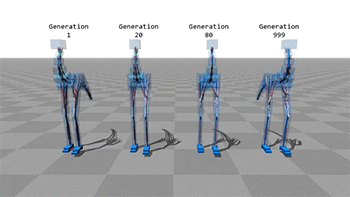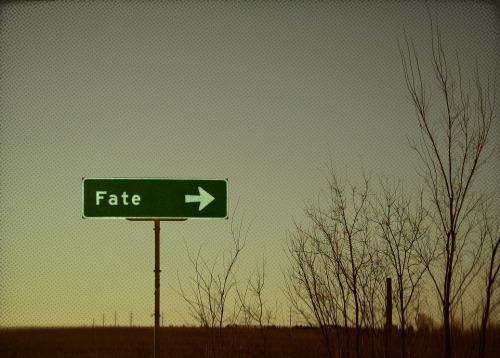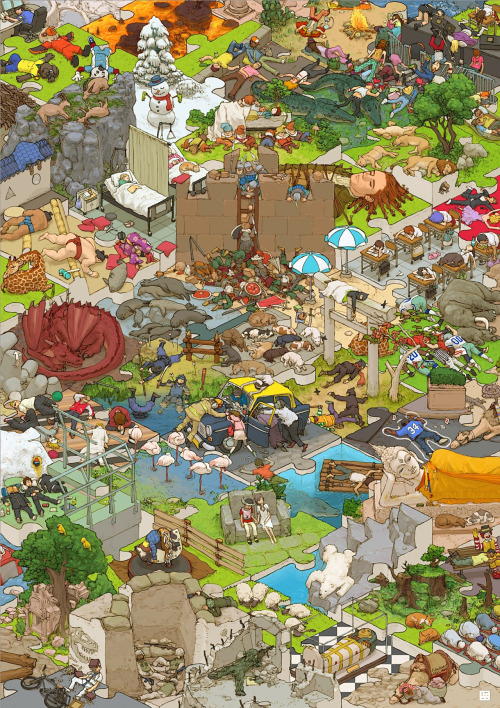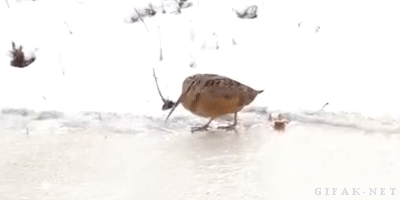Shared posts
Killer Mike's pre-show Ferguson Grand Jury speech.
ErinFrom a while ago, but I want to keep it forever.
Wilbur 2709

| Breed | Rottweiler mix |
| Gender | Male |
| Size | Large (50-90 lbs) |
| Neutered | Yes |
| Status | Available |
Wilbur could possibly be the world’s first Rottweiler and Potbelly Pig hybrid! This Rottie head/ Piggy body has won over everyone here at Muttville. With his his long body and short legs and his oh so handsome face, what’s not to love? Wilbur would love to be the newest addition to a home that can provide for him plenty of affection and help him lose weight at a healthy pace.
We think Wilbur is 8-10 years young, weighing close to 70 lbs.
As sweet as Wilbur is with people, he can’t be around cats and Wilbur would do best as the only doggy in the household.
Wilbur 2709 needs a new home! Click here to learn how to adopt him.

|

|

|

|

|

|

|

|

|
|||
| (Click on an image to enlarge) | |||
Instagramer @ihavethisthingwithfloors

Regram @weworewhat #ihavethisthingwithfloors emojiemoji

Regram @bmjaworski #ihavethisthingwithfloors (image flipped)

Regram @anouskapb #ihavethisthingwithfloors

Regram @sincerelyjules #ihavethisthingwithfloors

Regram @jennikayne #ihavethisthingwithfloors
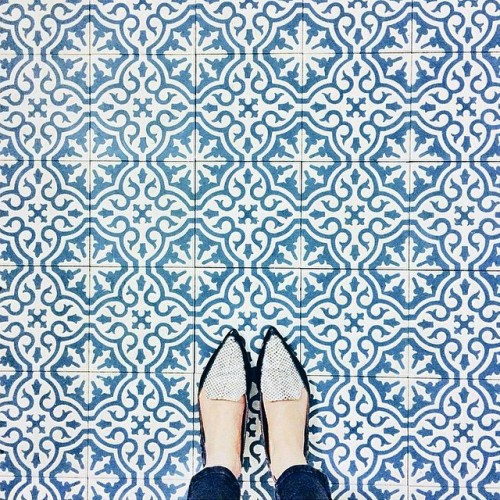
Regram @camtyox #ihavethisthingwithfloors

Regram @cassieklingler #ihavethisthingwithfloors
Instagramer @ihavethisthingwithfloors
‘We’re All Surrealists Now’: An Interview with Will Self
Adorable Dog and Baby Duo Practice Jumping Together
South Park - Please Drink Responsibly [HD]
catsbeaversandducks: Owls Are Flying Cats
Why Do Witches Ride Brooms?
According to an article by Megan Garber at The Atlantic, they did it for the drugs.
Starting in the 1300s, Europeans developed a taste for hallucinogenic drugs. Unfortunately, ingesting them often caused nausea and vomiting. Absorbing them through the skin came with fewer side effects and delivering them through the mucous membranes of the female genitals was ideal.
A physician quoted at The Guardian says the claim is medically sound:
Ointment would have been very effective as a delivery method… Mucous membranes are particularly good at transporting drugs – that’s why cocaine is snorted… Vaginal application would be pretty efficient, and the effects of the drugs would be noticeable quite rapidly.
According to legend, then, witches would coat the handle of a broom — a convenient household item — lift their skirts and get high.
The women who trafficked in hallucinogenic substances were often accused of being witches. Or, conversely, women accused of being witches were also accused of making magic ointments (from the fat of murdered children, no less). And witch experts in the 15th century claimed that they used these ointments not just to get high, but to get high; that is, that they literally flew using ointments.
Hence, witches on brooms.
Vintage witch poster for sale here.
Lisa Wade is a professor of sociology at Occidental College and the co-author of Gender: Ideas, Interactions, Institutions. You can follow her on Twitter and Facebook.'Twin Peaks' Revival to Air on Showtime in 2016

“Twin Peaks,” the ABC series that was a forerunner of today’s offbeat serialized cable dramas, is coming back to life with nine new episodes to air on Showtime in 2016.
Series creators David Lynch and Mark Frost are working away on the scripts, with Lynch planning to direct all nine episodes. The episodes are expected to bow in early 2016, which would coincide with the 25th anniversary of the show’s demise after two seasons on ABC in 1990 and 1991.
The new segs will be set in the present day and continue storylines established in the second season. Frost emphasized that the new episodes will not be a remake or reboot but will reflect the passage of time since viewers last checked in with key characters. As part of the deal, Showtime will rerun episodes from the original series’ first two seasons leading up to the 2016 premiere.
Frost would not elaborate on plot details or even the characters that will come into play. But the story threads that will picked up were “baked in to the last episode,” Frost told Variety. He called it “the next chapter of the story” and said that the passage of 25 years will be an important element in the plot.
“For those followers of the show who felt bereft when the show ended where it did all those years ago are going to like where it goes from here,” Frost assured. “And we hope that a lot of people who haven’t been to Twin Peaks yet are going to be equally interested in where the story goes from where we left off.”
“Twin Peaks” was ahead of its time in its unusual, often surreal approach to telling the yarn of a murder mystery in a fictional small town in Washington state. The show bowed with a ton of buzz — Lynch was red-hot as a feature helmer at the time — but it had little in the way of a sustained audience by broadcast TV standards of the day.
The series has remained a cult favorite over the years and thus was a ripe candidate for revival amid the general mania in the TV biz for reinventing vintage film and TV titles.
Lynch and Frost have retained ownership of “Twin Peaks” all these years. CBS has distribution rights to the show through the deficit-financing pact that Lynch/Frost Prods. set back in the day with Aaron Spelling’s Worldvision distribution arm, which CBS now controls.
Another key connection that helped the new-model “Twin Peaks” land at Showtime is the pay cabler’s Gary Levine, exec VP of original programming, who was the ABC exec who developed and championed the show during its original run.
Lynch and Frost have talked about taking another run at the Twin Peaks world over the years, but the effort got serious about three years ago when the two had one of their semi-regular lunches at Hollywood’s Musso and Frank Grill. It was not lost on either of them that “Twin Peaks” had proved to be a TV pioneer in many respects. Aspects of the show that were seen as a handicap in the ABC days are now pillars of the contempo generation of edgy cable and pay cable series.
“I always felt that in ‘Twin Peaks’ we were more or less filming a novel — drilling down to a level of detail you weren’t used to seeing in network storytelling,” Frost said. “Over the years a lot of people have credited us with inspiring them to think differently in how to tell stories. Now that we’re doing (the show) again, I’m happy to come back and get in on the action.”
Lynch and Frost didn’t shop the series around. Showtime was a natural home because of the latitude offered by pay cable, plus the comfort level offered by the connection with Levine.
“Showtime was the place we felt most comfortable going to after meeting with Gary and (Showtime prexy) David Nevins and seeing their passion for the show,” Frost said. “Gary we consider a good friend and David I’ve known for quite a while.”
There’s no word yet about casting. In the original series, Kyle MacLachlan (pictured) played the pivotal role of the Agent Dale Cooper, the FBI agent who comes to the small town to investigate the murder of homecoming queen Laura Palmer.
After that mystery was solved, the show explored even more seamy goings-on and oddball characters in the town. The pilot for the original series was shot on location in Washington state, but subsequent episodes were primarily lensed on stages in the San Fernando Valley. There’s no decision yet on a shooting location for the new segs.
Frost said it was still to be determined whether the revival will be a one-time limited series or an ongoing effort.
“The proof will be in the pudding. If we have a great time doing it and everybody loves it and they decide there’s room for more, I could see it going that way,” he said. The original “Twin Peaks” premiered on April 8, 1990, and had its last original telecast in June 1991. A prequel story, “Twin Peaks: Fire Walk With Me,” was released as a feature by New Line in 1992.
The TV series has endured for a new generation of fans through periodic homevid releases and more recently, a streaming pact with Netflix. The AFI hosted a tribute to the show in Los Angeles in July in connection with the Blu-ray/DVD release “Twin Peaks: The Entire Mystery.”
Given the show’s legacy and the rabid fandom it has inspired, Frost admitted that he and Lynch feel the pressure to make the new episodes worthy additions to the canon.
“We can’t rest on our laurels,” he said, which is a key reason why Lynch has committed to directing all nine hours.
“This show is a kind of thanks to all of the incredibly passionate fans we’ve had over the years that have kept the show alive and passed it down to the next generation,” Frost said. “We’ve been lucky enough to have one of the coolest, most intelligent, most inquisitive group of people attracted to our show. We’re happy for them that the show is coming back.”
In a statement issued by Showtime, Lynch and Frost quipped: “The mysterious and special world of Twin Peaks is pulling us back. We’re very excited. May the forest be with you.”
ivyarchive: mymodernmet: Illustrator Lili Chin's...






Illustrator Lili Chin's adorable series Dogs of the World illustrates 192 breeds of dogs grouped according to geographical origin.
More:
Yessssssss I knew there had to be more out there!
Don Hertzfeldt Couch Opening
ErinStill going strong!
The Simpsons episode opener
fuckyeahillustrativeart: by...

by Jimiyo
http://instagram.com/jimiyodotcom
http://jimiyo.tumblr.com/
(Joanna Newsom portrait - Harpist/Singer)
Attn finchdown, ganbattemotherfucker, likeapairofbottlerockets
(this showed up in that “Here’s a blog” slot on my dash just now)
Houston, You Have a Problem
Erin"In any industry other than sports, a laborer without a contract could work for any company in the industry and negotiate as high of a salary as the market would bear. Aiken’s only contract leverage is to go to college and play in exchange for having only part of his education covered, but in order to maintain that leverage, at least by the letter of the law, Aiken has to negotiate without professional help against a team of professional negotiators from Houston. Aiken isn’t old enough to vote.
"And Houston can do this because most sports fans are conditioned to be shocked when athletes make millions of dollars to play a game, but be OK when owners pocket tens or hundreds of millions for not playing a game."
A little less than two months ago, the Houston Astros used the no. 1 overall pick in the MLB draft to select Brady Aiken, a left-handed pitcher out of Cathedral Catholic High School in California. Within 48 hours, they had agreed to pay the 17-year-old a reported $6.5 million signing bonus, tying the highest bonus ever given to a high school pitcher, but still $1.4 million below slot value. Aiken was set to receive his payday and the Astros were set to save some change, and nobody gave the matter a second thought.
At least until Friday, when the signing deadline passed without Aiken actually inking a contract. What happened? Well, plenty, and very little of it’s good for Houston. The circumstances by which Aiken and the Astros failed to translate the deal from handshake to paper make this the most interesting transaction story since at least the Marlins–Blue Jays blockbuster trade in 2012, and this situation only stands to get more bizarre as time passes.
First, a little draft contract background: Most first-round draft picks sign professional contracts, but not all. It’s normal for one first-rounder to turn down his offer and try again later — even pitchers, and even relatively high first-rounders — and you might recognize certain players who’ve done so recently: Gerrit Cole, Karsten Whitson, Tyler Beede, Mark Appel, and now Aiken. While it’s less common for the no. 1 overall pick not to sign, it’s not unprecedented: Danny Goodwin didn’t sign in 1971 and Tim Belcher didn’t sign in 1983.
What makes Aiken’s case so unusual is that the Astros pulled their offer after his physical, which revealed that his left UCL (the ligament that gets replaced during Tommy John surgery) is unusually small. Even that isn’t unprecedented, though: In 1996, the Texas Rangers slashed their bonus offer to their first-round pick, R.A. Dickey, when a post-draft physical revealed that Dickey didn’t have a UCL in his throwing elbow at all. Back here in 2014, the Astros cut Aiken’s bonus offer from $6.5 million to about $3.1 million, the lowest number they could offer while still recouping next year’s no. 2 overall pick as compensation if Aiken failed to sign.
I’m not an orthopedist, so I can’t tell you whether Aiken’s small UCL will make him more injury-prone going forward. The problem is that even if I were an orthopedist, I wouldn’t be able to predict Aiken’s future based on what Houston found in his MRI results. By all accounts the small UCL is a congenital issue, not an injury, and Aiken has been playing at a high level for several years without any abnormal difficulty or discomfort. And that’s problematic for the Astros, because it means they reneged on a pre-draft deal following a physical that didn’t actually reveal that Aiken was hurt, or that he’d be more likely to get hurt in the future.
Aiken and his adviser, Casey Close, were justifiably taken aback by this turn of events, calling out the Astros for their shoddy practices and Major League Baseball for allowing this to unfold. In the uncertainty over the state of Aiken’s health, rumors began to swirl that the Tiny UCL Affair of 2014 was actually a smoke screen to cut Aiken’s bonus and use the savings to help sign other players. MLB regulates how much teams can spend on draft picks, and the Astros entered post-draft negotiations with an overall signing budget just north of $13 million. The league places a dollar amount on each draft pick in the first 10 rounds, so if you add up the numbers for each pick, you get the total salary cap each team is allowed to spend on its draftees. If one player signs for less than the recommended slot, the team can use the savings to sign other picks to richer bonuses, including players in the last 30 rounds, who’d ordinarily only be able to sign for $100,000. If a team goes over its spending limit, the league taxes the overage. If a team goes over by enough, it loses draft picks in coming years.
The Astros were particularly focused on trying to sign two other players: Jacob Nix, a high school pitcher from Orange County who, like Aiken, was nominally committed to play college ball at UCLA, and Mac Marshall, who was rated as a second-round talent but slipped to the 21st round because his stated commitment to play at LSU was so strong teams believed they couldn’t sign him. Remember the $1.4 million the Astros were supposed to save for signing Aiken below slot value? They’d earmarked most of that money for fifth-round pick Nix. The draft bonus slotting system allocated $370,500 for the no. 136 pick, but Nix had reached a verbal agreement for almost four times that amount. The Astros ultimately upped their offer to Aiken to $5 million in the minutes before the deadline, but Aiken was through negotiating by that point. When they failed to sign Aiken, the Astros lost the nearly $8 million associated with the no. 1 overall slot, and thus lost the cushion they’d planned to use to lock up Nix and, if possible, Marshall. If Houston’s attempts to lowball Aiken had worked, the team could have easily gotten him, Nix, and Marshall. Since those attempts failed, however, Houston lost all three, plus the money associated with their draft slots, which totaled more than two-thirds of the team’s overall 2014 draft budget.
And it gets worse. Aiken and Nix could file grievances against the Astros for breaking their verbal agreements and sue to become free agents, a status most recently granted to Barret Loux, the unsigned no. 6 overall pick in the 2010 draft. If Aiken and Nix fail to achieve free agency, both have the option of attending a junior college and reentering the draft next year or going to UCLA and trying again in three years.
There’s a chance UCLA may no longer be an option for Aiken, however, because both Astros owner Jim Crane and GM Jeff Luhnow made a point of saying they’d been negotiating with Close on Aiken’s behalf. Having an agent is against NCAA rules, though standard practice is to look the other way in the case of MLB draftees, unless someone drops a dime on the player. (You might remember an incident involving the Phillies early this year that got Oregon State pitcher Ben Wetzler suspended and made Jason Monda the most famous med student in the Pacific Northwest.)
While the overall level of complexity involved in this story is staggering, this last part makes identifying the blameworthy party very simple. The Astros, a multimillion-dollar corporation that could find $3.4 million in the change jar on the nightstand, tried to nickel and dime a kid who’s trying to break into an industry that’s stacked the deck against him, and then they tattled on him to the NCAA once they failed to get their way. Think about this: In any industry other than sports, a laborer without a contract could work for any company in the industry and negotiate as high of a salary as the market would bear. Aiken’s only contract leverage is to go to college and play in exchange for having only part of his education covered, but in order to maintain that leverage, at least by the letter of the law, Aiken has to negotiate without professional help against a team of professional negotiators from Houston. Aiken isn’t old enough to vote.
And Houston can do this because most sports fans are conditioned to be shocked when athletes make millions of dollars to play a game, but be OK when owners pocket tens or hundreds of millions for not playing a game. In the Ken Burns Baseball documentary, George Will, of all people, argued that because fans pay to see players, the players ought to get most of the financial rewards. Apart from sports fans, I don’t know who’s less labor-friendly than Will — Mr. Bumble in Oliver Twist, maybe?
Baseball’s amateur talent pipeline is a system that’s exploitative and deplorable from a labor relations standpoint even when management operates in good faith, and what the Astros did to Aiken is beyond deplorable.
On the eve of the signing deadline, CBS’s Jon Heyman quipped about the Astros ignoring the human element. I imagine he intended it as a cute little jab at the front office’s disregard for the traditions and norms of standard baseball practice, which Heyman, in conspicuously facile fashion, described as “sabermetrics.”
Still, Heyman stumbled onto the essential truth of the situation. This isn’t about sabermetrics or how the Astros chose to rebuild. This is distinctly about the human element. If your word is not your bond, if you’re willing to brazenly exploit teenagers to gain an edge, endangering their educational and professional futures out of spite, you might lack an appreciation for the human element. I’d say you lack humanity altogether.
Infamous SF Eviction Lawyers Use DMCA Claim to Silence Protest Video
Sana'a
Erin〜( ̄▽ ̄〜)(〜 ̄▽ ̄)〜
لابد من صنعاء وان طال السفر - You must see Sana'a, however long the journey
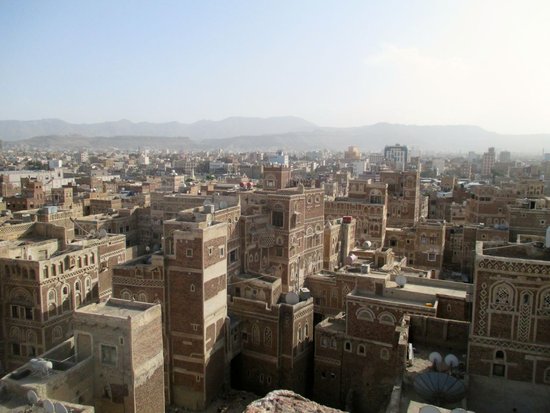
The scariest thing I'll see in Yemen looms up at me before the plane has even landed. I have dozed my way from Abu Dhabi across most of the Arabian Penninsula, including the Empty Quarter, that vast uninhabitable sandbox in the interior were they didn't even bother to put in borders until fifteen years ago. That just looked like storybook desert, although there was an appalling lot of it.
But now the plane is well into its descent to Sana’a, the flaps are coming down, and all I can see below is bare rock from which every trace of sand has been scraped clean by an angry and pitiless wind. At last I understand why it took three billion years for creatures to come out of the sea and colonize the land. One glimpse of these rocks is enough to send anyone flopping back into the ocean, tail tucked between not-yet-evolved legs. Enormous stone fingers point upwards, reaching nearly as high as the plane. Between them are deep scars where water in some inconceivably distant past rushed to get the hell out of this forlorn place. There isn’t the smallest trace of life, let alone human settlement. It is the most pitiless, hostile, and frankly malevolent landscape I have ever seen.
The plane crosses a high ridge and at last, thank God, there are some dark dots of vegetation. Fearless people are irrigating this bit of Lovecraftian madness. The dots turn into rows, then clumps, and soon in places I can see the white scar of a road. The mountains subside into a broad, flat, dun-colored plateau. As the plane dips a wing to begin its final approach, I notice that the monochrome ground becomes boxy and pixellated out towards the horizon, where thousands and thousands of tiny cubes seem to rise out of the desert, as if the Yemeni landscape had a bug in its loader.
The cubes are houses, hundreds of thousands of them, all the same color as the ground. That is my first view of the city of Sana’a.
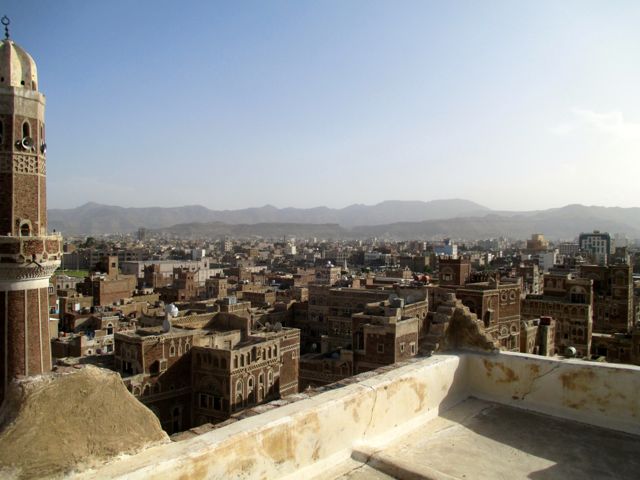
Sana’a is so strange and marvelous. If Yemen weren't in permanent crisis, the city would be awash in archaeologists, one of whom might even settle the question of how long people have lived here. Like Damascus or Jericho, Sana’a has a credible claim to be the oldest continuously inhabited city in the world. But what truly makes this place unique isn't its age, but its astonishing buildings. Old Sana’a looks like a gingerbread tribute to Manhattan.
While everyone else was content to build mud huts, tents, old caves or other basic dwellings, industrious Yemenis put up skyscrapers using only stone, mud, and lime. Confined by its protective wall from growing outwards, the city instead grew up, a forest of tower houses from five to nine stories high. These beautiful dwellings still stand, an ancient urban landscape where only the satellite dishes and metal water tanks tip you off that you are no longer in the Middle Ages.
It's hard to believe it when you're gasping for breath in a stairwell, but the tower houses of Sana’a are also quite practical. They allowed for a high population density within the city walls, permitted extended families to share a dwelling, and were handy in the real-life tower defense game against the hill tribes whose fondest activity for the past two thousand years has been plundering this lovely city.
Just as odd as the architecture is the city's climate. Tucked into the southwest corner of the Arabian Penninsula, near the mouth of the Red Sea, Sana’a is surrounded by some of the world's hotter deserts. By all rights, it should be a sweltering furnace like Riyadh or Khartoum. But because the plateau it sits on is over two and a half kilometers above sea level, the climate in Sana’a is positively mild. Northern Yemen may be the only place in Arabia where you can wear a sweater in June and live to write about it.
As the landing gear come down, I start to see details down in the streets. The pixel squares resolve into individual houses with chaotically unfinished roofs. Every rooftop has a low wall around it and has been capped off with a little cone of rubble. In between the houses there are long, stalled strings of cars, stretching out for kilometers. “Army checkpoints,” I think, but then I see that each thread of cars ends at a gas station. There are goats in the road, too. With their more flexible fuel requirements, they go where they please.
Right before the runway threshold, the plane passes a graveyard of Hind helicopters, rusted-out jet engines, and other airplane parts. The edge of the runway is lined with still functional helicopters, along with a row of big open hangars, each one sheltering a MiG fighter jet. It is terrifically windy. A vast Yemeni flag snaps in the breeze. Looking out at the barren landscape and tiny terminal, a single question wafts into my mind.
“What the hell am I doing here?”

Even with one tire out, the Soviet-made BTR-50 remains a formidable boot-drying platform
I've struggled for weeks to come up with a convincing irrationale for my visit, something more persuasive than the truth ("I really want to go"). The best I can do is steal an argument from my tour agency and stress that all the recent kidnappings have happened to Westerners who live in Yemen and have an established routine, not tourists who are tumbling through. I can cite the impressively thorough report on abductions in Yemen as proof that no tourist has been kidnapped since 2010, when two Americans were briefly detained. I can even picture the flipboard at the Yemen Ministry of Tourism:
[1382] days since last tourist abduction. Welcome to Yemen!
But it's possible tourists don't get kidnapped for the same reason there aren't many car accidents on the Moon. The few Westerners who come here tend to confine their visit to the old city, or the unequivocally safe (and remote) island of Soqotra. And there's no rule that prevents the bad people from changing their tactics if they get tired of staking out diplomats and English teachers. Given their scarcity, tourists in Yemen are about as inconspicuous as the Second Coming.
Kidnapping in Yemen used to be more fun. A disaffected tribe with a grievance would grab you for a week, play cards and chew qat, and then return you once the government had made whatever concession they were after. Lately, though, the kidnappers have been selling their victims to the local branch of al-Qaeda. Yemeni al-Qaeda is not particularly stabby, but they are serious about getting good value for abductees, and willing to wait as long as it takes to collect a solid ransom. They've kept some people for years. And they are probably no fun at all to play cards with.
The less vivid, but more likely risk is of just being in the wrong place when something bad happens. Maybe an American drone pilot will be having a rough morning in Nevada. Or maybe I'll be passing a government building as someone is detonating something to make a point. I promise myself to limit my time in the capital, try not to look too American (except from above), and avoid particularly risky spots like the Bab al-Yemen.
As my departure date approaches, I start to wake up with that hollow feeling that the body uses to tell the brain it's doing something stupid. The trip is getting uncomfortably real. Plane tickets are bought for actual money. My visa comes through, removing my best hope for weaseling out without chickening out. And then one bright morning I find myself in Abu Dhabi, overcrowded travel hub to the world, standing at the gate in a line full of grandfathers wearing headscarves. There aren't many of us foreigners on this flight, just an older Filipino man and a young Chinese couple. A woman behind me asks me if she's in the right line for Sana’a. It's the only time on this trip I'll be addressed by a Yemeni woman whose face I can see.

Sana’a International is not a sprawling, perfumes-and-Cinnabon kind of airport. My tour company has told me to look for a visa window as I enter the terminal, promising me it's easy to find. They weren't kidding. The arrivals hall is a single room, with passport booths at the far end and two holes in the wall on the left. The first hole is a currency desk, where a man in a synthetic suit sits quietly with an open briefcase of money in his lap. There is an exchange rate board hanging up, but all the numbers on it read 00.
The Chinese guy approaches me and quietly asks if this is a scam. I'm equally confused, but I figure if they're scamming us already we may as well just empty our pockets. He goes off to confer with his partner while I trade two hundred euro for a small mountain of very dirty green thousand-rial notes. I can see a figure on the baggage claim side of the window waving to get my attention, motioning for me to move to the visa window. My ride is waiting for me!
Showing my ignorance, I attempt to stand in line at the visa hole. Queuing is not done in Yemen; it demonstrates passivity and a shameful lack of seriousness about the task at hand. The correct approach is to press forward and assert your claim as loudly as you can; it's up to other people to shout you down. Friendly hands propel me forward and I shove my passport into the window.
A big fellow in the visa line asks me where I'm from. He's wearing an embroidered skullcap and the Abe-Lincoln-style beard of a devout Salafist.
“I'm American,” I tell him.
“Oh,” he says, visibly surprised.
“Where are you from?”
“Pakistan.”
I shake his hand heartily and introduce myself, and it's only a few minutes later that it occurs to me to wonder what a devout Pakistani dude might be doing in Yemen.
(And some days later, when I've had time to learn that Yemen is full of ancient mosques, and that scholars from all over the world come here to study, I will feel like an ass for assuming that this guy was anything but a religious student. I mention both reactions here to illustrate how useless my gut instincts are before I've even technically entered the country.)
I watch my passport circulate until it emerges from the wall. Yemen has never developed the fetish for bureaucracy that dogs so much of the Arab world. I notice on my visa that they got tired of writing out my name and just stopped halfway through. The border guards stamp me in and release me into the custody of my contact and driver, who have been waiting patiently in the terminal. Five minutes later, I've been bundled into the back of a Land Cruiser and we are heading downtown.
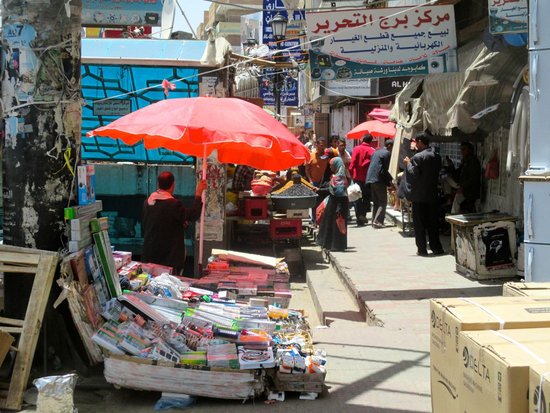
There are about a dozen military checkpoints between the airport and central Sana’a, but getting through them is a breeze. Usually there are three soldiers; one of them pokes his head in the car and Ali the driver says 'guest' or 'tourist'. Another verifies that the back seat is not piled with RPGs; the third dozes in the shade of a nearby armored vehicle. Ali has the checkpoints timed perfectly; he can roll through most of them without stopping.
I never do figure out the Yemen camouflage scheme. Each checkpoint seems to have its own look. Most popular is a 'leopard' camo (bright yellow background with dark shapes), but the visually arresting purple and fuschia combo comes in a strong second. Very occasionally an iconoclast soldier dresses in colors that might be found in nature. The armored vehicles at the checkpoints are similarly festive. Not many of them look ready to swing into immediate action. One APC still has the cover on its gun barrel, hanging off limply like a burlap condom.
In between the checkpoints is a broad road full of traffic, noise, and blowing dust. Pedestrians position themselves like pit crews, ready to ask for alms or sell trinkets whenever the cars slow down. Women in full niqab go from car to car, carrying ill children. Small kids run over trying to sell a box of tissues or a pitiful flower. The traffic never really stops or even forms into recognizable lanes; people just squeeze in and around obstructions as necessary. Whenever we pass a truly epic tangle of cars, it inevitably marks a gas station. None of the pumps are working.
The transition to Old Sana’a is abrupt and astonishing. The ramshackle cinder block buildings turn into iced gingerbread houses, and suddenly I'm in the middle of the pictures that I have admired for so long online. Central casting has even provided a camel; he stands meditating across the street from the hotel.
At the hotel gate I'm introduced to Fouad, my guide, and I have to bodily push him back into the courtyard to avoid breaking the Slavic taboo against shaking hands over a threshold. It's rude and awkward, but I'm in a place where I can't afford to take chances.
The Felix Arabia is the only hotel that is still open in the Old City, and today I will be its only guest. They have graciously put me on the fourth floor, where I'll have views of the entire city, and Fouad waits for me to make the long climb upstairs. I can really feel the altitude; my legs start to wobble after the second flight of stairs, and I have to stop at all the landings to catch my breath.
Fouad is a slight guy around my age, with wide-set eyes and a wispy moustache. He's dressed in a coat and slacks rather than the thawb-and-dagger outfit that most men here seem to favor. Almost as soon as we start walking, he turns to me and asks:
"Tehuzzin?"
"What does that mean?"
"This is an important phrase. It means, do you chew qat?"
"Well of course! When in Yemen!"
We settle on a plan. Fouad will show me the city, we'll have lunch, come back to the hotel, chew some qat, and then take a walk again in the evening when the light is at its prettiest.
Walking around Sana’a as a white dude gives me an inkling of that it's like to be famous. As we follow the narrow streets, I see my own pie-eyed reaction to the architecture reflected in the faces of passing children, who are just as surprised to see a foreigner as I am to see a six-hundred-year-old skyscraper. Adults are more circumspect, but it's obvious that I am attracting attention. Fouad is an excellent minder. He keeps me moving, unobtrusively but efficiently, through little street after little street. A lot of people come up to welcome me to Yemen. Kids and a few adults ask me to take their picture.
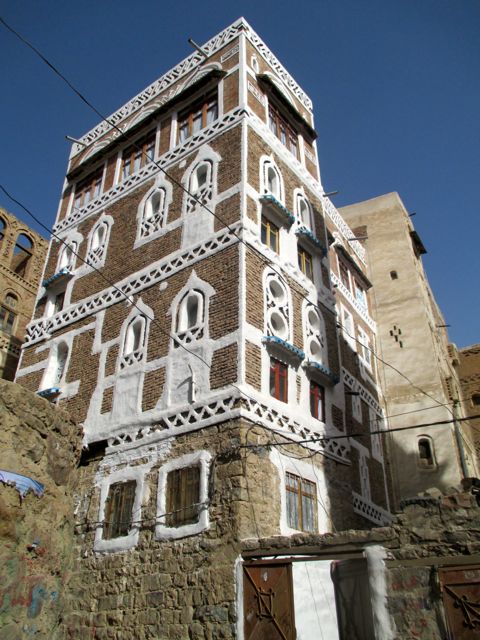
It's not any individual building that makes Sana’a so incredible, but rather the cumulative effect. The towers are full of curious details.
From the outside, the buildings look like confectionery. The icing is decorative white trim made from lime. There are some ornamental and structural features that I see again and again. Many houses have a sort of carved stone cage affixed at some of the windows that serves as a cooling station for meat or water. It’s set up so that the breeze will blow through and chill whatever's inside. There is a lot of strategic draught management in Yemeni architecture. While the city can get hot, it is also nearly always windy, and this is fully exploited to keep structures cool.
There are also highly decorated, carved wooden boxes mounted onto some of the higher windows. These were—are—a way for unveiled women to look out into the street without raining shame down upon their household.
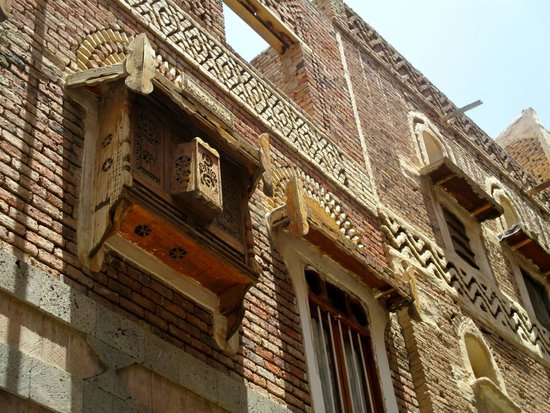
(The veiling thing is seriously creeping me out. I've been in Yemen's capital city for hours and I have yet to see a woman's face. They move like black ghosts through the streets of Sana’a, and the niqab works as intended—it's really easy to forget that they're even there. On this one issue I've hit the limits of cultural sensitivity. Carry an AK-47, chew qat, wake me up at four with an ear-splitting call to prayer, I don't care. But this veiling business has got to go.)
Many of the houses have a white vertical gutter coming down from an upper floor, mercifully no longer used, which once served as a sanitation system. The city used to be a far more pungent place. Human waste would be collected, dried, and used to stoke fires in the large Turkish baths, thick hemispherical structures that look like vast bread ovens placed in the landscape.
Near the hotel we pass a large walled garden, about a city block in size. It is divided into numerous small lots. Fouad explains that each tower house got its own allotment of land, to use as a vegetable garden or to grow herbs to sell. The practice is falling into disuse as families move out of the Old City. The ground belongs to the nearby mosque (in a perpetual endowment called a waqf) and the garden is irrigated by water from the ritual ablutions required before prayer. It's a small example of how self-sufficient the city used to be, before half the country tried to move here.

"So what do you think of Sana’a so far?" Fouad asks me.
“It's incredible. I've never seen anything like it. But I am just a little bit afraid.”
He stops and looks at me seriously and says:
“Don’t worry. Don’t worry at all. We are together. If something happens to you today, it will happen to me. If you die, I will die with you!”
I would also have accepted “there's nothing to worry about”, but I'm touched by how seriously he answers me. Life is very difficult for people here right now. There are no jobs, no fuel, and no sign that things might get better. The tourist sector is dead. Walking me around Sana’a today is the first paid work Fouad has had in three weeks. He has more pressing problems to deal with than the vague anxieties of a pampered visitor. But he's looking at me with real concern.
One thing Arab and Slavic cultures share is a belief in the comforts of fatalism. Sometimes it's nice to sink into the inevitable like an overstuffed armchair.
"It's all written up there," I suggest, pointing melodramatically at the sky.
He brightens.
"That's exactly right. Maybe we die today, maybe we live another fifty years. It is already written. Insha'allah."
“Insha'allah”
And he takes me by the arm to go buy some qat.

The qat seller is a gentleman sitting cross-legged with a big black sack on his lap. He opens it to reveal individual bags of leaves, the kind of vaguely salad-like baby greens you would expect to pay twenty dollars for at Whole Foods. Part of the ritual of buying qat is a minute botanical examination of the plant. The seller lets the qat out of the bag long enough for Fouad to reject half a dozen packets. After some back and forth, the price settles at two thousand rials (four bucks) for two bags of young leaves.
Physiologically qat is a stimulant, but in Yemeni culture it plays a social role akin to alcohol. Qat is what you buy for your guests at a wedding. Qat is what you blow your paycheck on. Qat is what keeps you out late with your good-for-nothing friends. You can chew qat alone, but the best way to enjoy it is with a group of other men, seated together in a mufraj (the Yemeni lounge and chillout room). Ideally you set aside a block of four or five hours in the afternoon to get nice and lit. People who can rarely afford qat might stay up all night to chew it, minds racing. Habitual users usually start their session after lunch and spit out the wad before bedtime. You're not supposed to chew qat on an empty stomach, and since you can't really eat (nor do you feel hungry) once there is a big lump of the stuff in your cheek, it's normal to wait to chew until after the big meal of the day.
We take our new stash to a restaurant, a big tiled room with one wall open to the street. Women are selling fresh-baked bread in the doorway, and Fouad buys us two disks the size of manhole covers, thin and still very hot. Yemeni bread is unbelievably tasty for the first hour after baking; after that it turns into a regular kind of chewy pita. A cookpot the size of my first apartment simmers away on a platform by the entrance.
The restaurant is dark, dirty, and minimally furnished. There’s a jerry can of water at each table, but Fouad warns me not to drink it. It is for Yemeni stomachs only. While he's off finding me bottled water, the waiter brings over a little boiling iron cauldron of saltah, the Yemeni national dish. There's a yellow foam on top that looks like melted cheese.
Saltah is a meat stew. The yellow foam is whipped fenugreek (hilbeh), a bitter and mucilaginous herb that people tell me is an acquired taste. It is supposed to do wonders for the digestion. The server brings us several bowls of room-temperature broth that we can pour into the cauldron to moderate the boiling.
The protocol in Yemen is to eat with your right hand. The bread serves as a heat shield for the fingers, and you depth-charge your way in and try to grab pieces of meat without scalding yourself or your neighbors. Maybe we eat the fenugreek layer first, or maybe I adjust to the taste and start to like it, but by the end the meal is delicious.
On my way out, my path is blocked by some other diners, who are calling out to me. It takes me a second to process what's going on.
"Please take our picture. Welcome to Yemen!"

This kind of thing happens everywhere. I can't overstress how welcoming the men in this city are to visitors. Yemenis love their country, and they show great affection to those who make the effort to come see it.
After lunch, a man's fancies naturally turn to tea. Fouad asks me if I want to sit and drink at a tea stand, or take the stuff to go in a plastic cup. We're very close to the Bab al-Yemen, the main gate where the Old Town connects to the heart of the road network in the new city, the one place in Sana’a that I don't care to linger. So I suggest we drink on the run. Like an idiot, though, I reach for an actual glass of tea instead of the plastic cup that has been poured for me.
It's a beautiful day. It feels frankly foolish to be worried here, like some hayseed in New York City terrified he'll be mugged the second he sets foot in Times Square. The mood on the street is the opposite of tense. People are strolling comfortably along the broad plaza, and the Bab al-Yemen itself is lovely, a striped layer cake of colored stone. I sit, grin, and silently burn my mouth in my haste to get through that damned cup of tea.
The hotel has a mufraj right off of the reception desk and for the moment, we have the space to ourselves. Fouad shows me how to relax in the Yemeni fashion: you lie on your side, with your elbow on a bolster, and place one foot on top of the other so that one knee points upwards in a kind of jaunty Tom Selleck pose. It's important not to point the soles of your feet at people. Yemeni men have all kinds of techniques (which I mercifully don't have to master) to avoid upskirt situations while sitting or reclining.
The qat lesson is easier than the sitting lesson. You chew the leaves and softer stems down to a pulp, then push that mass into your cheek. The thicker stems go in the trash. You let the chewed-up leaves sit in your cheek and work their magic.
The hotel manager walks in on us and chastises Fouad for letting me eat qat out of a plastic bag. This is no way to introduce a stranger to qat! He takes my stash and brings it back a minute later, washed and neatly arranged in a cloth.
Qat is no taste sensation. You can enjoy a similar experience at home by sprinkling Sanka on a houseplant. There's a definite astringency to the leaves that makes me pucker my mouth and have to take many tiny sips of water. But it's also not particularly vile, nowhere near as bad as tobacco.
"How do you like it?" Fouad asks.
"It's not as good as the fenugreek," I tell him. He clicks his tongue impatiently and tells me to wait an hour. "You'll be flying like a bird!"
Some of the other hotel staff are starting to arrive, each man with his own bag of qat in his hand or tucked into his shirt. One thing I quickly come to love about Yemen is the absence of small talk. People may eventually ask you where you're from, what you do, and even what you think about the weather, but not before they've tried you out in some real conversation.
Topics under discussion today include the World Cup, the economically devastating expulsion of Yemeni workers from Saudi Arabia in 1991 (when Yemen's president rashly backed Saddam Hussein), the wisdom of the adage ‘give praise in public, criticize in private’, and whether or not it's an insult to praise the beauty of a foreign man's wife in his presence. This last point is raised by the desk clerk, who has learned to say “your wife is very beautiful” in five languages and argues passionately that there's nothing unseemly about stating facts.
The conversation ebbs and flows. These guys spend every afternoon together, there is no time pressure. People ebb and flow too; sometimes a man will come in and just sit for a while without speaking, then leave the room. Women chew qat as well, but they do it in their own world, which I will never get to see.
At one point when it's just me and Fouad again, he says:
“You know how you've been saying today you're Polish and American?”
“Yes?”
“Maybe as you travel outside Sana’a, don’t talk about living in America. Maybe it’s better to just say you’re Polish.”
“Is it dangerous to say I’m American?”
“No, no, it’s fine. There’s no danger. Just for some people, maybe it’s better if you say Poland.”
“Thanks, Fouad.”
“No problem.”

The afternoon light has turned Sana’a into a different city, and I'm on the right drug to appreciate it. The slanting rays bring out all kinds of detail in the buildings, and the qat is making me feel chatty. Only the difficulty of Arabic grammar keeps me from talking Fouad's ear off. Every man we pass is boasting a golf-ball sized lump of qat in his cheek, and it's comforting to know that in this small way, I fit in.
Most of the men I see on the street are wearing either a thawb or a shirt with sarong-like skirt that wraps around the hips. They also wear a Western-style suit jacket, which gives them a curiously elegant and formal look. Nearly every man wears a jambiyah, the curved ceremonial knife so emblematic of the country, positioned right at navel height. The women, as I've said, are uniformly veiled in black.
Fouad takes me into a tower house that has been restored and set up as a kind of museum. On the ground floor are the three things every tower house required: a grain store, a mill wheel, and a well. The second floor has a kitchen. The third floor has a film crew. They are shooting a period soap opera and are very unhappy with our presence. Ramadan is coming up, the biggest month for television in the Arab world, and they are on a tight schedule. We negotiate passage to the upper floors with the promise that we'll be quiet and leave almost immediately.
Before the days of television crews, the lower residential floors were reserved for womens' quarters, the men lived above them (of course), and the top room in the tower was set aside for an opulent mufraj, with cushion-lined walls, elegant teapots and panoramic views of the city. In between some landings there are cubbyholes that look big enough to hold a large dog. This is where servants would curl up to sleep.
There are some clever details to these houses. The windows are set low to the floor to keep the sun from heating up the rooms too much at midday. Above them are beautiful semicircles of stained glass, called moon windows. Many of the windowpanes in the stairwells are made from alabaster instead of glass, preserving privacy while letting in a beautiful white light.
There's even a neat system for storage. "Closets" and pantries are recesses in the wall up near the ceiling. To get to them, you pull out sliding planks mounted into the walls that form a little temporary staircase.

From the roof, the city is breathtaking. I mean that literally. I am gasping from the altitude, and it doesn't help that the steps in these houses are so exceptionally steep. I enjoy the view in every direction while Fouad points out the highlights. The gigantic, kitschy mosque in the distance was built by Yemen's former strongman Saleh, to make sure the country would always remember him. It's rumored to be full of weapons, and there's even said to be a tunnel connecting it to the presidential palace. Saleh's old buddies refuse to let the army come inside. Closer in is the Ministry of Defense, where fifty-six people died in a bomb attack in December. And just over this nearby rooftop is the American embassy, which was attacked by a mob in late 2012. At this point Fouad has to take a call, and I am relieved to have him stop pointing things out.
Sana’a is a city full of problems, but the biggest problem is hiding under our feet. That well in the basement is never going to draw water again. Sana'a is on the point of running completely dry.
There are no rivers in Yemen. Sana’a used to get by with wells, but back then Sana'a was a much smaller city. In modern times, the population has exploded, from sixty thousand residents in the nineteen forties to estimates of over two million today (the country is too broken for an actual census). The days when you could sink a well from your basement are long gone.
In the seventies, you might hit water after drilling a few dozen meters. Today there are wells going dry that are over a kilometer deep. The water table is dropping by two meters a year. The city is drinking fossil water deposited thousands of years ago, and what's worse, using it for agriculture. Part of the urgency in my trip is the worry that there won't be a city to visit for much longer.
In a less broken country, the water crisis would dominate every facet of public life. In Yemen, public life is a joke. The government is so corrupt and paralyzed by crisis that it can't perform the most basic tasks. The city's wells are completely unmonitored; no one even knows how many there are. Private owners will keep drilling for as long as they can, but at some point even the deepest wells are going to run dry. And then something awful will happen.
Old Sana’a may survive as some kind of a museum exhibit, but in a matter of years (not decades) the rest of this vast city will have to move or die. The situation is so dire that the previous government seriously considered moving the capital to the stifling Red Sea coast, or somehow piping desalinated water over the three kilometer high mountains that separate the capital from the coast, at inconceivable expense.
It's hard to look at a city this old and imagine it could just go away. But the numbers don't add up. There isn't enough water here for two million people. There certainly isn't enough water for two million people and agriculture. But how do you tell a desperately poor farmer to stop growing qat? And who is going to make him listen?
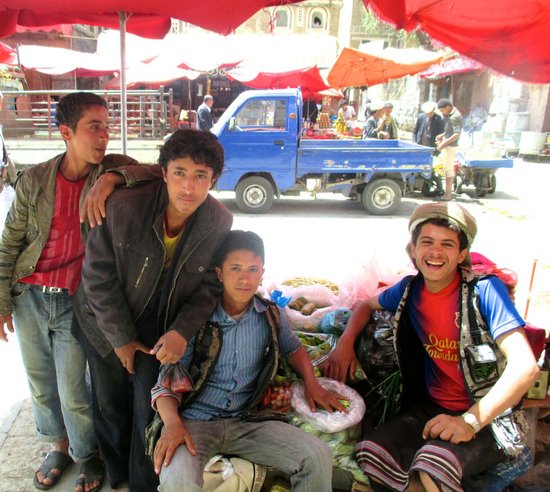
The streets have grown livelier now that the sun is not so high. The market is filling up with silent black ghosts. Most of them have toddlers in tow. Fouad takes me through the pungent spice market to the large Souq al-Milh (salt market) where everything is on sale, from men's decorative daggers to textiles to cookware. This is technically the most touristed spot in Yemen, yet there's not a single t-shirt store or even postcard stand in the place.
Having just come from Morocco, I'm used to mild commercial harrasment and the kind of instant street friendships that end with one party bringing home a carpet. So Sana’a really puts me off my stride. Merchants who yell out 'hello' really just want to say hello. If I stop and engage them, they ask me where I'm from, welcome me to Yemen, and send me on my way. A lot of people insist I take their picture with no expectation that they'll ever get to see it themselves. It's a upside down world for a tourist.
Watching Fouad teaches me how to move through public spaces. You never stop to let people through; you just adjust your pace and path to squeeze by as necessary. People in tight spaces will flow like a liquid, and it turns out that if everyone presses forward, the system works. The only way to screw up is by being unpredictable in your movements, or trying to apologize. People who need to get through more urgently will yell or honk as they're coming up behind you. Tomorrow I'll learn that this system applies also to driving, and works just as well. For now it's enough to experience it on foot.
We stop in at the Great Mosque, the only place that I don't feel fully welcome. I am only allowed to step onto the threshold. Fouad urges me to take a picture, though I would prefer not to. Someone bumps my knees with the shoes they're carrying in their hand; I can't tell if it's a passive-aggressive gesture or not, but I'm happy to move on. The Great Mosque is more impressive for its antiquity than its appearance; like many of the earliest mosques, it is very plain and somewhat blocky. This one was built while Mohammed was still alive. I look up with apprehension at the massive loudspeakers on the minaret, pointed directly at my hotel room.
We stop at this great little cafe—you've probably never heard of it—that used to be a caravansarai. The building is an old courtyard where merchants coming in from the city would tie up their camels and rest. Now a man in the doorway makes the most delicious coffee I have ever had, a kind of Yemeni frappucino with evaported milk, cinnamon, cardamom, sesame, and a whole lot of sugar. And here is a pair of European tourists, the only sighting of the day! Russians! For whatever reason, only the former Warsaw Pact and Italy are still visiting Yemen. Even the Germans, normally hard to rattle, have moved on.

Like a gentleman, Fouad gets me back to the hotel before nightfall, and I have the chance to survey the place. There is a Russian book on the table—Mohammed, Prophet of God. A sign in the bathroom reminds me in English that I am in a "traditional Moslemic society" and should take care not to parade naked in front of the low windows where half of Sana’a can see me.
My last appointment of the day is down in the courtyard, with Tina Zorman, who along with her husband runs the tour operator Eternal Yemen. The days when you could travel in Yemen by yourself are gone, and now every foreigner needs an itinerary, a driver, and a security escort, all approved by the Ministry of Tourism. Tina is coming to brief me about my itinerary and answer my questions before sending me out into the countryside.
I have been looking forward to our conversation, hoping a fellow Slav might help me get my bearings and give me a culturally reassuring point of reference. But Tina is a Slovenian woman with an Arab soul. As if to demonstrate the verbal effects of qat, she monologues for over an hour before we get anywhere near the topic of my upcoming trip. I realize that if I want to be a part of this conversation, I will to have to fight my way in.
The itinerary is pretty much fixed; a standard loop through the small triangle of Yemen where tourists are still allowed to go. I have already met my driver, Ali, who I will come to recognize as a prince among men. The security situation is safe, Tina assures me, but she likes to wait until the last minute to submit the itinerary and request the permit. "It's better not to give too much notice." That means we won't find out until tomorrow morning how many soldiers are coming on the trip.
I know from reading a blog post by Wandering Earl (a guy who looks like he would drink your last beer out of the hostel fridge) that American citizens get a military escort in Yemen. Unfortunately, a few weeks before my arrival the Tourism Ministry expanded this policy to cover all visitors. Even Polish citizens are no longer safe from the protection of the Yemeni armed forces.
When I was planning my trip, traveling with soldiers sounded like it might be a fun, wacky thing to write about. But now, on the eve of my departure, it just sounds like a hassle. It's hard to keep a low profile with a squad of soldiers by your side. Tina is even less happy about it than I am. She will have to feed this private army and supply them with qat and a place to sleep.
(A week later, when I find myself surrounded not just by soldiers, but by an entire company of tanks, with a Hind helicopter buzzing over our heads for protection, I'll think wistfully back on this moment. The government of Yemen cannot guarantee your safety, but it makes sure you'll go down swinging.)
The power goes out halfway through our talk, and we're left sitting in dark for a while, until the hotel can spin up its generator. “You're going to want to buy some batteries and a flashlight. This happens pretty much every day.”
That evening I wait up in my room for the generator powered lights to go off. Blackouts are so common in Sana’a that the hotel has installed an entire parallel lighting system that runs off the generators. Unfortunately, there's no way to switch these lights off. I feel very conspicuous, silhouetted in my turret against the night sky while I can't make out anything of what's happening in the streets below. The situation perfectly captures what it feels like to visit Yemen. Outside the city is dark, except for the far-off flashing neon of a modern casino hotel. There are invisible people down in the streets yelling at each other, and from time to time I can hear the sound of running footsteps. A red tracer bullet drifts up over the Presidential mosque, a few miles away. As best I can tell, this is just a normal evening in Sana’a.
Eight more days to go!
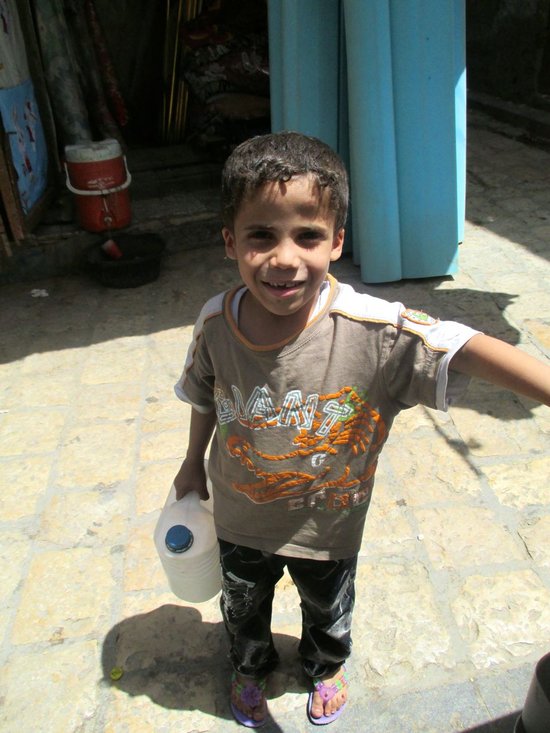
Saving the Wearable
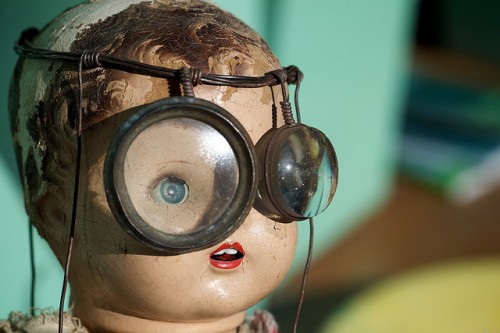
Image From Jeremy Brooks
The wearable is going through an adolescence right now. Products like Google Glass, Oculus Rift, or the Pebble smartwatch are a lot like teenagers: They’ve come into their own, but still aren’t sure about the place in society. They are a little awkward, have problems staying awake when they need to be, and they attract derision by the New York Times. And just like human adolescence, this phase probably has a horizon. People could warm up to the idea of face computers, battery life will get better, and (eventually, hopefully) the public will learn to ignore Ross Douthat. But for right now, the wearable is in a precarious situtation. Are wearables like Glass relegated to the same fate as Bluetooth earpieces and the Discman, or can they be saved? Is the entire category irredeemable or have we yet to see the winning execution?
Let’s begin by listing some of the stated problems with wearables. The first and probably best document is Google’s own “Do’s and Don’t’s” guide for Glass explorers. We can pretty fairly assume that 1) not enough people were doing the “Do’s” 2) too many people were doing the “don’ts” and 3) these issues are generalizable across similar devices.
The Don’t’s aren’t very surprising: ask people before taking photos or videos of them, don’t stand around in public staring up into your Glass, and when people ask you about it or request that you take it off, be an adult and acquiesce to reasonable requests and questions. What’s really interesting are the “Do’s” and the very first “do” in particular:
“Glass puts you more in control of your technology and frees you to look up and engage with the world around you rather than look down and be distracted from it.”
A typical rebuttal to the Digital Dualism critique is that it is inherently and uncritically a “pro-technology” argument. That debate has been hashed out elsewhere and continues to grow and develop but it is worth noting here that this is not just a tech company but one of the biggest tech company on the planet making a digital dualist statement: that smartphones distract you from “engaging with the world.” It assumes that there is a “virtual” and a “real” world and that Glass is the perfect solution to the dualism: you can dip into and benefit from the latter without losing track of the former. Its an insidious idea that will make even the biggest and most successful organizations solve problems that don’t exist. Or, perhaps worse, create new problems that could be avoided with relatively simple social theory.
Consider for example, the fairly mundane act of taking a photo. With a phone your body posture makes it fairly obvious that you’re taking a picture: Glass isn’t as obvious. Glass’s prism lights up when its recording a video but this doesn’t mean a whole lot if those around you don’t know what it means when the prism on your face begins to glow. Short of projecting [REC.] on the user’s forehead, body posture might be the best indicator of the device’s state. If Glass required the user to continue touching the side of the device during recording it would not only present a much more obvious indication that the user was interacting with the device, it would also make it physically uncomfortable to record for long stretches of time.
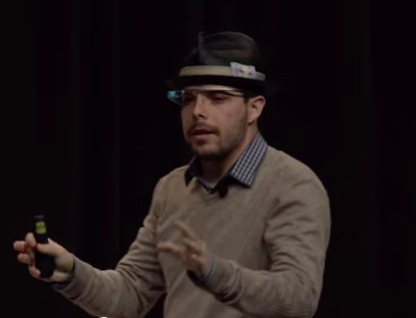
Image captured by the author from “Building New Experiences with Glass“
What I just described is a problem with a designed solution but it is informed by several sociological observations. The biggest of which is that all knowledge and practice is situated within a culture. Really big changes to cultures –like the kind Glass and other wearables promise for the tech industry– don’t just adhere soundly to existing orthodoxy, they make new logics and reinterpret existing narratives. Making recording video slightly more difficult is counter-intuitive to what we commonly consider good design and the underlying logic of Google Glass in particular. In fact, if there is a single unifying narrative that connects all consumer devices, it is the idea that technology is best when it is invisible. Devices are meant to be desired (albeit guiltily) but ultimately looked past. Or, as Google Developer Advocate Timothy Jordan said at SXSW 2013 while wearing Google Glass and a fedora: “By bringing technology closer, we can get it more out of the way.”
The idea that the most pleasurable experience with technology is the one you barely notice goes back several decades. Legendary designer and living avatar of German minimalism Dieter Rams, for example, has been prescribing “Good design is unobtrusive” for over 30 years. Echos of Rams’ “Ten Principles of Good Design” (unobtrusiveness is number 5) can be heard in every product announcement and commercial going back for decades. When Steve Jobs introduced the iPod in 2001 it wasn’t pitched as a “hard drive in your pocket” but as “1000 songs in your pocket.” Our devices are supposed to “get out of the way” and let us experience something pure and even visceral. The ideal device would be completely invisible.
This “invisibile device” approach to product design has produced immensely useful and entertaining devices but is, ultimately, a beautiful lie. Technology is always framing scenarios, affording certain social actions at the expense of others, and encouraging (and at times forcing) us to think in terms of likes, tweets, and photos. Designers want their devices to look beautiful but are also taught that the virtual is obtrusive. It is no wonder then, that Glass Explorers are having such a hard time: they’re sold a device that you’re meant to forget because technology is obtrusive, but that obtrusiveness manifests itself every time someone looks at you because you have this device hanging from your face. The sales pitch is that Wearables will make tech fade into the background but maybe that isn’t what the best tech looks like. Maybe the orthodoxy is wrong. After all, interaction with your data may appear unfacilitated and that might feel good, but I suspect that the pursuit of invisible devices breeds Glassholes.
It’s hard (at least for me) to look at Ram’s Ten Principles of Good Design and not think about what Donna Haraway called the “immodest witness.” Scientists and engineers are prone to thinking that their observations and conclusions are self-evident and that their gaze comes from nowhere; that they are not interpreting or translating the natural world through their own standpoint, but merely describing it in an impartial way. This means that undesirable social phenomena like racism or sexism can masquerade as natural phenomena. If you believe without question (as many scientists did and unfortunately still do) that women are naturally subservient to men or that there are clear, separate, and distinct human races, then you’ll go out and find justification for that kind of thinking in your data.
A similar kind of structural bias can be found in Silicon Valley. Back in January I wrote about this phenomena and observed that,
When something isn’t quite designed to your lifestyle you experience it as “I love this thing but I don’t understand why it does X, Y, and Z.” It would seem to follow then, that design incompatibilities between designed object and user would become increasingly obvious as any given user drifts further away from the intended user of the designed object. But that is, generally, not the case. Design something that’s just a little off, and it’s an itch you can’t scratch. Design entire product categories with only specific people in mind and its difficult to imagine the material world any other way.
This issue is blaringly obvious in the demo videos for Glass. A white man (invariably) does a bunch of upper middle class things to impresses a woman. We see, quite literally, the perspective of heteronormative white men and all the things they need to live a better life. It also shows the self-centered behavior that comes with extreme privilege: information is for your eyes only and the world stands ready for your gaze and enjoyment. A small design intervention like the one I described above for image capture asks that the user acknowledge that they are not passive or modest; that the user at least continue to exert some kind of energy in order to take or do what they want.
Can the wearable be saved? Its a difficult question to answer because it is unclear whether the motivating factors for creating the wearable –digital dualism, invisible devices– are the only thing making them desirable. To save the wearable as a device category is to confront and overcome the long-standing, intersecting oversights in the tech industry: assumed body norms, patriarchy, and the clunky way engineers and businessmen talk about “the social.” This isn’t a pedantic problem relevant only to Silicon Valley elites. Solving (or at least coming to a better understanding of) what is wrong with wearables could make for a more inclusive and thoughtful culture of technological development.
David is on Twitter and Tumblr. Also at davidabanks.org
250 New Emoji Introduced Today, May See Inclusion in Future Versions of iOS
ErinMiddle Chinese; [e] picture + [moji] letter, character
The resemblance in form and meaning to emoticon n. is probably coincidental.
According to the Unicode Consortium, the new emoji characters are primarily derived from characters used in the Wingdings and Webdings fonts, as seen in an example image:
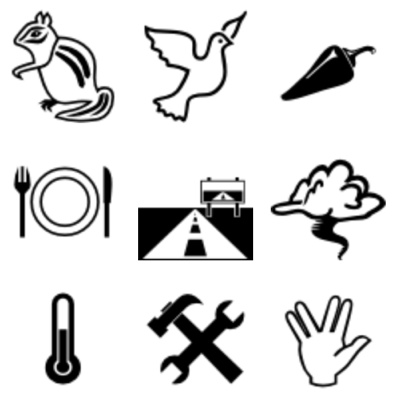
As noted by The Verge, Unicode member platforms like iOS and Android will need to implement support for the new standard and create pictographs to represent the emoji, which are only described by Unicode in plain text.
A full list of the new emoji names can be found on Emojipedia, which includes descriptions for each future emoji. A few examples are posted here:
- "white sun behind cloud"
- "man in business suit levitating"
- "derelict house building"
- "chipmunk"
- "flying envelope"
- "reversed hand with middle finger extended"
Earlier this year, Apple began working with the Unicode Consortium to introduce more characters to its emoji offerings, adding diversity to the character set, but this update does not seem to focus on people emoji.
The Unicode update will also see the addition of new currency symbols for the Russian ruble and Azerbaijani manat, 23 lesser-used and historic scripts, plus many other symbols.
vizual-statistix: Unlike like Emperor Kuzco, I was actually...
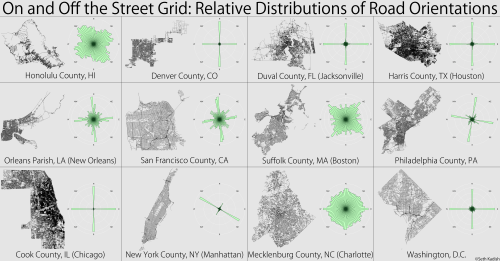
Unlike like Emperor Kuzco, I was actually born with an innate sense of direction. If you’re like me, and you use the Sun to navigate, you probably appreciate cities with gridded street plans that are oriented in the cardinal directions. If you know that your destination is due west, even if you hit a dead end or two, you’ll be able to get there. However, not all urban planners settled on such a simple layout for road networks. For some developers, topography or water may have gotten in the way. Others may not have appreciated the efficiency of the grid. This visualization assesses those road networks by comparing the relative degree to which they are gridded.
To generate the graphic, I first calculated the azimuth of every road in ten counties (plus one parish and D.C.). I tried to choose consolidated city-counties to keep the focus on urban centers, but for larger counties, I opted not to clip the shapefile to the city boundary. All calculations were made in a sinusoidal map projection using the central longitude of the area of interest. I then graphed the angles on rose diagrams (wind roses) using bins of 5° to show relative distributions for each area. The plots were scaled such that the maximum bar height was the same on each rose. To ensure rotational symmetry in the plots, each azimuth was counted twice: once using the original value and once using the opposite direction (e.g., 35° and 215°). As such, all streets, regardless of one-way or two-way traffic, were considered to be pointing in both directions.
The plots reveal some stark trends. Most of the counties considered do conform to a grid pattern. This is particularly pronounced with Chicago, even though much of Cook County is suburban. Denver, Jacksonville, Houston, and Washington, D.C., also have dominant grid patterns that are oriented in the cardinal directions. While Philadelphia and New York are primarily gridded, their orientations are slightly skewed from the traditional N-E-S-W bearings. Manhattan is particularly interesting because it has a notable imbalance between the number of streets running the width of the land (WNW to ESE) and the length of the land (NNE to SSW). New Orleans and San Francisco express some grid-like forms, but have a nontrivial proportion of roads that are rotated in other directions. Downtown Boston has some gridded streets, but the suburban grids are differently aligned, dampening the expression of a single grid on the rose diagram. Finally, the minimal geographic extents of the grids in Charlotte and Honolulu are completely overwhelmed by the winding roads of the suburbs, resulting in plots that show only slight favoritism for certain street orientations.
If you want to see more detail, a full-resolution version of this graphic can be downloaded here:
https://www.dropbox.com/s/my7y24hrzvhagce/Road_Orientation.png
Data source: http://www.census.gov/cgi-bin/geo/shapefiles2013/main
Script for azimuth calculation: http://www.ian-ko.com/free/free_arcgis.htm















